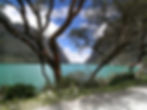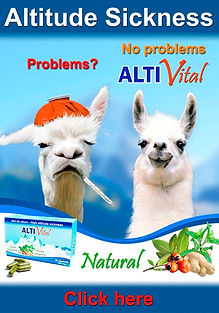
PERU INFO

Unusual Peru
The records of Peru
Geography
La Rinconada
the highest city in the world
This small city of 50,000 inhabitants, a mining town located in the department of Puno on the border with Bolivia, is classified by National Geographic as the highest city in the world at 5,100 meters (16,728 ft) above sea level. The second highest city is also located in Peru, Cerro de Pasco (Central Andes) at 4,338 m (14,229 ft), the third is Potosí in Bolivia at 4,090 meters (13,415 ft) a.s.l.
Lake Titicaca
The highest navigable lake in the world
At 3,810 m (12,497 ft) above sea level, it is the highest navigable lake, refering to navigation by large boats. With an area of 8,562 km2 (3,306 sq mi), 174 km (108 mi) long and 70 km (44 mi) wide, shared by Peru (56%) and Bolivia (44%), lake Titicaca has a maximum depth of 283 meters (928 ft) near the island Soto. It is the largest lake in South America, lake Maracaibo has a larger surface area but it is a bay, not a lake, due to its direct connection with the sea.
Huascarán
The highest tropical mountain in the world
Located in the center of Peru in the Cordillera Blanca 6,768 m (22,199 ft) above sea level, Huascaran is the third peak of America after Aconcagua (6,962 m / 22,835 ft) and Ojos del Salado (6,893 m / 22,609 ft) both in border of Argentina/Chile and the highest in Peru.
Allpahuayo-Mishana
World record of diversity in fauna and flora
20 km (12 mi) from the city of Iquitos in Peru's northern jungle, this little reserve is impressive for its diversity and World Records as the largest number of varieties of trees per hectare (300), the largest variety of reptiles (140), amphibians (112), primates (17) and birds (600) in a locality. The park also has nearly 2,000 species of plants including a hundred endemic to Peru as well as a dozen vertebrates and 28 species in danger of extinction such as the giant otter, the harpy eagle, the monkey tocón negro (collared titi), the monkey guapo rojo (bald-headed uakari) and the giant armadillo.
Amazon river
The longest and more powerful river in the world
Two international scientific expeditions, one led by the Polish explorer Palkiewicz in 1996 and another by the Peruvian and Brazilian Insitutes of Geography in 2006, were able to determine precisely the source of the Amazon river on a snowcapped called Quehuisha (5,150 m / 16,892 ft) into the Quebrada Apacheta near the Nevado Misti (Colca Canyon - Arequipa, southeast of Lima).
These scientists made new calculations and with 7,062 km (4,388 mi) exceeds 300 km (185 mi) the Nile (6,756 km / 4,198 mi) previously considered the longest in the world. The Amazon also has the record for the highest discharge with an average of 209,000 m3 / sec (7,400,000 cu ft/s), equivalent to the 7 other rivers with more discharge in the world together (Congo, Ganges, Orinoco, Madeira, Yangtze, Negro and Rio de la Plata). The Amazon is responsible for about 20% of the Earth's fresh water entering the ocean.
As most of the rivers in Peru, it changes its name in each region that crosses. So is called successively Apurimac, Ene, Tambo, Ucayali and finally takes the name of Amazon where unite with the Marañon river near the city of Iquitos in northern Peru.
Iquitos
the only major city in the world that is inaccessible by road
Located in the heart of the jungle and reached only by airplane (1 h 45 from Lima) or by boat from the city of Pucallpa. The journey can take between 2 and 7 days depending on the size of the boat, currents and mood of the captain.
With 495,000 inhabitants, Iquitos is the capital of the department of Loreto and the sixth-largest city of Peru.
Chicama
the longest left-hand wave in the world
The Chicama beach also known as Malabrigo, 70 km (43 mi) north of Trujillo and 600 km (373 mi) north of Lima, is known by surfers for its fast and hollow waves, particularly the longest left-hand wave in the world that can reach 2.5 km (1.6 mi) long and 1-2 meters high.
In 2012, the world junior champion of surfing, the Peruvian Cristobal de Col, set a Guiness World Record by completing 34 carvings in 2 minutes and 20 seconds.
Fauna and flora
Potato
The world's largest varieties
The Peruvian Ministry of Agriculture has identified 2,321 native varieties of potatoes and 91 wild species. The oldest remains have been discovered in the Chilca canyon (65 km / 40 mi south of Lima) and date from 8,000 BC.
Incas gave it the name "papa", but the Spanish conquistadors confuse it with sweet potatoes (batata in spanish) previously found in South America and changed the name to "patata" (potato in english).
Puya Raimondi
The largest number of flowers in the world
It is a wild species endemic to the Andes and is one of the most amazing plants on earth.
It can reach 12 m (40 ft) in height, produces up to 8,000 flowers once in its life when reach 100 years old and then die leaving 6 million seeds.
Puya Raimondi grows between 3,200 and 4,800 meters (10,000 - 16,000 ft), the best known forest is ubicated in the Huascaran National Park center of Peru.

Vicuña
The finest and most expensive wool in the world
The vicuña, of the same family as the llama, has the finest animal fiber in the world, with an average of 12 micrometers in diameter. In comparison, cashmere has 17 micrometers, alpaca 24 and sheep 50.
This fineness and great rarity, make it the most expensive wool of the world, sold US$500 per kg freshly shorn. Almost all production is for export in rich countries and a vicuña garment reaches high prices.
A vicuña wool scarf costs US$500 (price in Peru) and a topcoat can cost over US$30,000.
History
Caral – Supe – Between 3,000 and 1,600 BC.
The first civilization in the Americas
It is located on the coast 200 km (124 mi) north of Lima. Caral is the first civilization in the Americas, consisting in a structured and organized society. Archaeologists little known about this culture currently under study, only it was a gentle, religious and agricultural civilization. The city of Caral is open to the public since 2006.
The Atahualpa's ransom
The biggest ransom in history of humanity
Captured by the Spaniards on November 16, 1532, Inca Atahualpa realizes that the Spaniards are very interested in precious metals, which for the Incas have a ritual value. The Inca offered to buy his liberty by filling the room where he was kept prisoner with gold and the two following with silver "up to the level of the reach of his arm".
Pizarro received 6 tons of gold and 12 tons of silver, corresponding in present value to US$300 million or 240 million euros.
After fulfilling his part, the Spaniards sentenced him to death for idolatry, fratricide, polygamy, incest and accused him of hiding a treasure. He was executed on July 26, 1533.
Curiosities
The Magic Water Tour
the world's largest fountain complex
Inaugurated in July 2007 in the Park of the Reserve located a few blocks south of the Park of the Exposition (Avenida Petit Thouars), the fantastic Circuito Mágico de Aguas is registered in the Guinsess book of Records as the world's largest fountain complex in a public park.
13 ornamental and interactive fountains offer a show with music, light and laser effects.
Señor de los Milagros
the most important Catholic procession in the world
It is held not only in Lima, but also in most of the Peruvian cities and in 70 cities in the world.
The Lord of Miracles is also known as the Cristo de Pachacamilla, Cristo Morado (Purple Christ), Cristo de las Maravillas (Christ of Wonderland), Cristo Negro (Black Christ) or Señor de los Tembores (Lord of the Earthquakes). He is credited with many miracles and during the month of October several processions take place in downtown Lima.
Mistura - Lima
the largest gastronomic festival in Latin America
For 10 days, all actors of Peruvian cuisine are present in Lima, from farmers to chefs, bakers, cooks, waiters, school canteens, etc.
You can taste the Peruvian specialties, attending conferences of national and international chefs, attend musical performances and cooking contests.
An unforgettable day to explore the delicious gastronomy of Peru.
Gastronomy
Peru
awarded as the best international culinary destination
Thanks to the diversity of its cuisine and the great quality of its chefs among the best in the world, in 2012, 2013, 2014 and 2015, Peru has been crowned as World's Leading Culinary Destination by the prestigious academy World Travel Awards considered as tourism Oscars.
Cebiche
Premiado como el mejor plato del mundo
It is the signature dish of Peru, raw fish "done" with lemon juice, herbs, hot pepper, traditionally served with a piece of boiled corn, sweet potato and onion.
It can be prepared with different types of fish, the classics are the corvina drum, sole and seafood.
The ceviche of the chef Javier Wong in his restaurant Sankuay - Chez Wong in Lima, was honored in 2014 as the best dish in the world by Chowzter, an academy composed of international food critics.
Economy
Mining
Peru is the first world's producer of silver and zinc
Peru currently produces almost 112 million ounces (3,650 t) of silver annually, 17% of the world production, followed by Mexico and China.
Peru is also the second largest producer of copper and fifth in gold.
agricultural production
Peru is the world's leading exporter of asparagus and organic bananas
Peru is the world's leading exporter of asparagus (fresh and canned) with 127,000 t in 2013 ahead of China and Mexico.
It is also the largest exporter of organic bananas and paprika, 2nd of avocado, 3rd of artichokes, mangoes, 4th of coffee.
Fishmeal and fish oil
world's largest producer and exporter
Peru is the world's largest producer and exporter of fishmeal and fish oil destined for 193 countries.
Peru has 600 fish boats, mostly small wooden ships for artisanal fisheries. 130 plants produce more than 2 million tons of fishmeal per year.
Today is the best animal feed, containing nearly 80% of high quality protein and rich in essential fatty acids omega 3, EPA and DHA, essential for the rapid growth of animals as poultry, cattle, sheep, pigs, fish, crustaceans and algae.
The benefits of fish meal are:
-
Reduce production costs allowing rapid growth with better feeding an increase in fertility and a decrease to the risk of disease.
-
Improvement of the quality of fats and disease resistance for pigs.
-
Increase milk production for cows.
Unusual Peru




